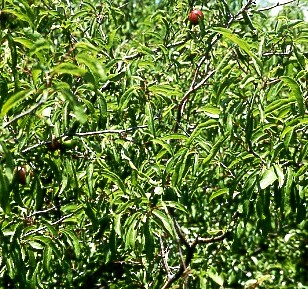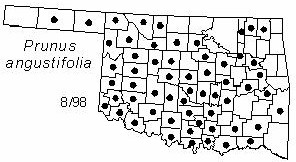
Shrub to 3 m (9 ft) tall, forming dense clonal thickets. Crown irregular. Bark red-brown to dark gray with thin scales; prominent lenticels. Twigs lustrous red-brown, pubescent. Leaves alternate, simple; lanceolate or oblong-lanceolate, 2.5-5 cm (1-2 in) long and 8-16 mm (0.3-0.6 in) wide, glabrous or slightly pubescent beneath; lustrous green above, paler beneath; rounded and broadly cuneate at base, acuminate to acute at apex; margins sharply serrate with glandular teeth; petioles 6-12 mm (0.25-0.5 in) long, slender, glabrous to pubescent, may have 2 red glands near the apex. Flowers in umbels, glabrous with 2-4 flowers about 8 mm (0.3 in) in diameter; calyx-tube campanulate, glabrous, 5 lobes; petals 5, white; styles 1; stamens 15-20; flowers appear from March to April. Fruits drupes, 12-18 mm (0.5-0.75 in) in diameter, globose, red; fruits mature May to July.
Distribution: Oklahoma and Texas , north to New Jersey, south to Florida and west to Louisiana. Common.
Habitat: sandy soil. Fencerows and thickets.
NWI status: none
Comments: Prunus is the classical name for European plums; angustifolia refers to the narrow leaves.
Horticulture: Easily grown from seed or transplant.
Food uses: The fruits can be eaten raw or cooked. They are often prepared as jelly or preserves. Native Americans sun dried the plums for winter consumption, but not all tribes removed the pits first.
Wildlife benefits: The fruits of Chickasaw plum are eaten by several species of birds and mammals. The dense thickets also provide cover.
Distribution in Oklahoma: 
BACK
NEXT
RETURN TO INDEX
Last update: 9/15/99
 Go to Oklahoma Biological Survey Home Page
Go to Oklahoma Biological Survey Home Page
 Disclaimer
Disclaimer